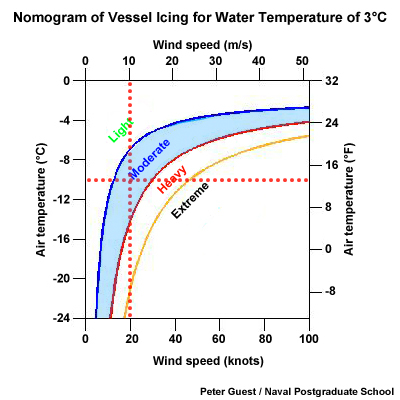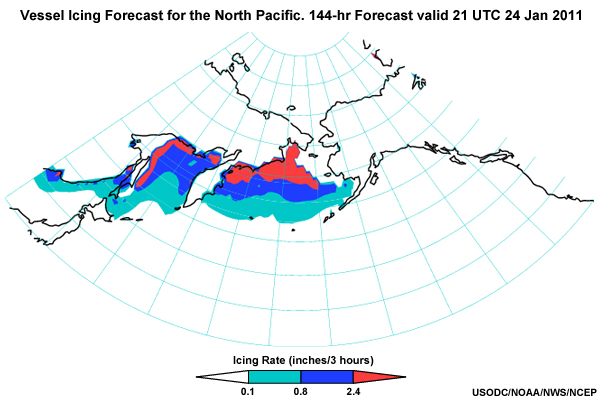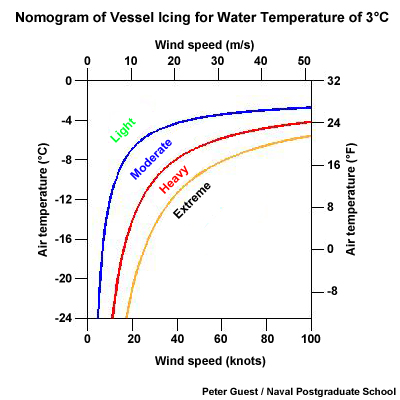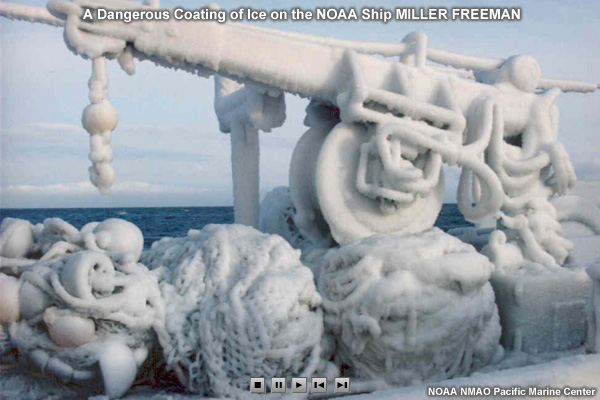Table of Contents
Vessel Icing
Vessel IcingEffects and Causes
Vessel icing from sea spray can result in loss of stability and even capsizing of ships, particularly smaller vessels. Ships with large superstructures and low freeboard are particularly vulnerable.
Sea spray icing is caused by a combination of several environmental factors, including
- Air Temperature
- Water Temperature
- Freezing Temperature of Water
- Wind Speed
- Wind Direction, Relative to the Ship
- Wave Characteristics
- Wave Size
- Wave Length
- Wave Propagation Direction
Icing occurs when sea spray becomes supercooled and freezes on contact with the ship. It can start to occur when the air temperature falls below the freezing point of water, -1.7°C (29°F) for sea water. Icing potential increases as air and water temperatures drop and wind speed increases. Icing rarely presents a problem if the water temperature is above 6°C.
The most intense icing conditions occur within 200 km of a shore or ice edge with strong, cold offshore flow. As air moves offshore, it gradually warms in response to heating from the sea. Once the air temperature rises above freezing, icing does not present a problem.
Wind and wave characteristics, relative to the direction the ship is heading, determine how much sea spray strikes the vessel superstructure. Travelling faster and into the wind and waves will increase sea spray reaching the deck and superstructure, and thus increase icing. Smaller boats will be affected more strongly. Ships that have been "cold soaked" in very cold temperatures for several days may experience more severe icing than otherwise expected.
Vessel IcingPrediction
Overland (1990) developed a method that predicts icing for vessels 20 to 75 meters in length that are steaming into the wind. Icing rates can be classified as follows:
| Icing Class Icing Rates |
None | Light | Moderate | Heavy | Extreme |
| (cm/hr) | 0 | <0.7 | 0.7 - 2.0 | 2.0 | >4.0 |
| (in/hr) | 0 | <0.3 | 0.3 - 0.8 | 0.8 -1.6 | >1.6 |
| Overland (1990) | |||||

This nomogram was developed from the Overland icing algorithm. It shows results for a water temperature of 3°C, typical of the Bering Sea. In this case, a windspeed of 20 knots at a temperature of -10°C results in moderate icing.
Icing nomograms are available at: http://www.weather.nps.navy.mil/~psguest/polarmet/vessel/predict.html#nomogram

Overland's icing prediction method also provides the basis of forecast products produced by the National Weather Service. They use weather parameters forecast by the GFS to create icing predictions like that shown here.
NOAA Vessel Icing Prediction Website: http://polar.ncep.noaa.gov/marine.meteorology/vessel.icing/.
Vessel IcingAvoidance and Mitigation
Conditions that lead to icing are associated with cold air advection within 200 km of shore and cold water temperatures. If you can avoid these conditions, you will avoid most icing. If you cannot, the best thing to do is seek immediate shelter. If shelter is not available, steer the vessel downwind to minimize sea spray.
Once ice has formed, it can be removed with a variety of tools, the best of which are baseball bats and large wooden mallets. The wooden tools cause less damage to the ship and equipment than metal tools, but having extras is good as they often break. Remove ice as soon as possible, before the buildup becomes dangerous.
Chemicals (like rock salt) can help prevent the buildup of ice or aid in its removal. Heaters may be used to remove ice from small, critical areas, but are not effective for removing large amounts of ice.
Vessel IcingQuestions
Question 1
Which of the following factors increase icing? (Choose all that apply.)
The correct answers are a) "decreasing air temperature," c) "distance <200 km from shore," and d) "increasing wave height all increasing icing potential."
Decreasing air temperature cools spray. With enough cooling it will freeze on contact with the ship. Increasing wind speed and wave height both increase the amount of spray in the air. A ship travelling into the wind will generate more spray, too. Cold offshore winds gradually warm from contact with warmer water. Winds that travel more than 200 km offshore have typically warmed enough that icing does not present a problem.
Question 2
For ships 20-75 meters in length, an ice accumulation of an inch per hour would be classified as which of the following? (Choose the best answer.)
The correct answer is c) "Heavy."
The NOAA icing classification is as follows:
| Icing Class Icing Rates |
None | Light | Moderate | Heavy | Extreme |
| (cm/hr) | 0 | <0.7 | 0.7 - 2.0 | 2.0 | >4.0 |
| (in/hr) | 0 | <0.3 | 0.3 - 0.8 | 0.8 -1.6 | >1.6 |
| Overland (1990) | |||||
Question 3

Based on this nomogram, what sort of icing would you expect for the following conditions:
Water temperature = 3°C
Windspeed = 20 kt (10 m/s)
Air temperature = 14°F (-10°C)
(Choose the best answer.)
The correct answer is b) "Moderate."
Vessel IcingReferences
This section draws heavily upon a vessel icing tutorial by Peter Guest available at http://www.met.nps.edu/~psguest/polarmet/vessel/ and http://www.vos.noaa.gov/MWL/dec_05/ves.shtml
Operational products are available at http://polar.ncep.noaa.gov/marine.meteorology/vessel.icing/
